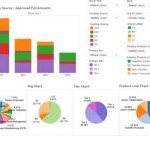27 August 2019
Organizations reported spending a total of $87.6 billion on training costs in 2018. Each organization’s learning and development (L&D) team collects data about the training and learners from various sources. The data drives the justification for future training investment by providing organizational leadership the return on investment (ROI) insights and facts.
Facing the Data Challenge
Unfortunately, L&D directors cannot simply open a dashboard to retrieve any desired analytics on the learners and thereby the training. To have a complete learner analytics view, L&D directors must task their teams to gather “unstructured” data (ex: instructor-led, webinars, focus groups, etc.) and “structured” data (ex: LMS, mobile, etc.).
Requirements for “Unstructured” Data
L&D teams perform the daunting task of first gathering all the “unstructured” data in a single location before any analyzing can occur using designated programs. The “unstructured” data is gathered from instructor-led, webinars, or focus groups. These are usually verbal or hand-written responses which must be typed or transcribed into a spreadsheet before analysis can begin. Part of the analysis will be a search for common phrases in the responses. However, in a spreadsheet of 1000s of responses, this will be a time consuming process for the L&D team.
Requirements for “Structured” Data
Beyond the “unstructured” data, “structured” data is gathered from the LMS or mobile training platforms. These platforms usually provide “structured” data in a spreadsheet that includes details about assessments, completion rates, optional training material usage, etc. This format allows L&D teams to easily analyze the “structured” data for any issues or insights for future training sessions.
AI Learner Analytics Solution
However, L&D teams desiring to analyze “unstructured” data for the same result or to compare “unstructured” and “structured” data for commonalities will find difficulties due to incompatibility with the sources. This leads to missed conclusions, data points, and insights on learners and training.
Utilizing Text Analytics
Our team’s AI for text analytics functions in a way similar to our brains. The algorithms process whole paragraphs and lines of text to gain understanding and classify in themes. Our analyst will train a set of “agents” based on the desired insights from the L&D team. A single agent is responsible for one theme. The more open-ended responses processed the better at predicting outcomes, classifying, and identifying themes. After training, agents are “turned loose” on the entire set of open-ended responses, yielding a comprehensive scoring and ranking of the themes expressed by your learners. As the agents analyze more data, they will need to be adjusted based on the scoring results.
Customized AI Learner Analytics Solution
Our team’s personalized AI solution provides access, summarization, exploration, analysis and interaction capabilities to L&D teams. We collaborate with the organization’s L&D team to first design and develop a solution based on the needs and capabilities. We ask questions to determine what themes or insights are the targets for the textual data. This establishes what agents will be built for the text analytics. Other considerations include:
- Single interface or dashboard ability to view data.
- Interactive dashboards built to specific needs.
- Data extracted and appended within designated entities and sentiments (dashboard areas).
- Supplemented with an open intelligence for context.
- Provide domain specific core concepts and themes using our AI technology.
- Provide maintenance through cloud service or on premise service.
Conclusion
Data for L&D directors is available in “unstructured” and “structured” data formats. Unfortunately, it is time consuming for their teams to sufficiently collect and analyze. Our team assists in designing and developing an AI solution which will provide the learner analytics for your organization’s L&D team to not only justify the training but also improve overall training effectiveness through unidentified insights and data points.
We customize each AI learner analytics solution to meet each L&D team’s needs while remaining flexible and cost effective to the organization. Our team also considers the AI solution as an application for any type of training analytics (i.e. predictive analytics – safety training, sales analytics, etc.). For additional information, contact us.







